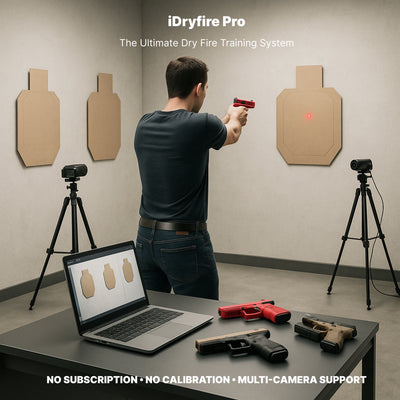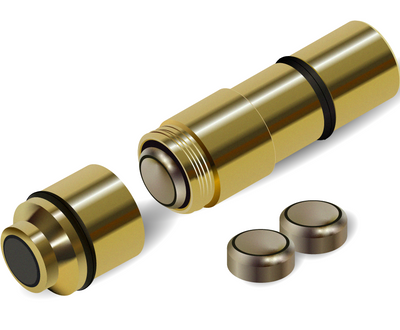iDryfire Path™ - LaserLess Diagnostic Dry-Fire System Instructions
🔧 Quick Set iDryFire Path Hardware
-
⚠️ Safety First (video “Safety First” included)
Always treat the firearm as if it is loaded.
Before proceeding, personally verify that it is unloaded, clear, and safe to use.

-
📌 Mounting Guide (video “ Mounting Guide” included)
-
Place the Path clamp onto the Picatinny rail.
-
Hand-tighten until it's firm and wobble-free.
-
Clamp the Phone: Open the phone clamp, place the phone centered, then close the clamp.

Calibration Instructions
🛠️ Calibration Steps (video “Calibration Steps” included)
1. Target Setup
Secure the included target in its designated position.
🎯 Use the Included 3-Inch Target - No Substitutes
To ensure accurate hit/miss detection, you must use the included 3-inch target exactly as provided. This target features a specific color and pattern optimized for the system’s recognition algorithm. Do not substitute, resize, or modify it - doing so will result in missed or false hits.
If displaying the target on a TV, monitor, or tablet, use a physical ruler to verify that it measures exactly 3 inches across. Adjust your screen zoom or scaling settings as needed to match the correct size.

2. Initiate Calibration

Camera Scanning Tip for Optimal Calibration
Begin from your shooting position and gently sweep the camera across the target’s background using the following motion pattern:
• 🔄 Side-to-side: pan left to right, then right to left
• 🔼🔽 Vertical sweep: tilt upward and downward, then reverse
You will need to scan the wall in a continuous "snake" pattern to map the wall boundaries.
* Start by aiming at the top-left corner and moving the firearm smoothly and slowly to the right until you reach the edge of the wall.
* Lower the firearm to the vertical center to move smoothly from right to left.
* Lower your aim again, pointing towards the junction where the wall meets the floor to move from left to right, ensuring the camera captures the floor-wall edge clearly.
This is already a good wall scan, but to improve it even further, you can transition immediately into a 3 vertical columns scan.
* Move your aim upwards to the top left (or right) of the wall.
* Shift to the center then move smoothly downwards toward the floor.
* Shift again to move smoothly upwards one final time.
📌 Pro Tip: Avoid rapid or jerky movements. Smooth, consistent motion yields the best results.

3. Close-Range Target Scan
Move closer to the target

Scan the target as you would a QR code.

4. Final Alignment and Fire
Return to your original position, aim at the target, and perform a dry fire shot.

5. Confirmation
Calibration is now complete.
Practice Settings

Tap or click ❓ next to any feature to view a brief explanation or guidance tailored to that setting.
SELECT NUMBER OF TARGETS

-
A single-action firearm uses only ONE active target. You may use multiple inactive targets and one active target for dynamic drills.
Example Flow for 1+ Targets for a single-action gun:
-
Wait for the Buzz.
-
Begin the drill when the signal sounds.
-
Engage: Aim at Inactive Target.
-
Acquire and confirm your sight picture without firing.
-
Transition: Shift aim to the next inactive or active target.
-
Engage Active Target: Aim, acquire, and confirm your sight picture, then dry fire.
-
For training guns, double-action guns, or guns with a dry-fire trigger reset, you may select multiple targets.
Example Flow for 1+ Targets:
-
Wait for the Buzz.
-
Begin the drill when the signal sounds.
-
Engage: Aim at Inactive Target.
-
Acquire and confirm your sight picture, then dry fire.
-
Transition: Shift aim to the next inactive or active target.
-
Engage Active Target: Aim, acquire, and confirm your sight picture, then dry fire.
SELECT PAR-TIME

PAR-Time Options
-
Option A: Choose how long you have to complete each action before the timer beeps.
-
Option B: Control drill speed with timed start and stop cues.
"Select PAR-Time" in shooting practice means setting a time limit for completing a drill or action. It's used to train speed and consistency by giving you a fixed window to perform a task, such as aiming and firing, before the timer signals the end.
PAR-Time Tip: Start with a longer time window if you're new to PAR-Time.
As you improve, gradually shorten the time to increase the challenge.
SELECT NUMBER OF SESSIONS (Repetitions):

Session Reps & Progress Tracking
-
Set your desired number of back-to-back sessions.
-
Each session auto-launches - stay sharp and consistent.
Post-Set Strategy:
-
Analyze your performance metrics.
-
Repeat sets until measurable improvement is achieved.
-
If performance plateaus under fatigue, consider ending the session to preserve training quality.
SELECT RESTART DELAY BETWEEN SESSIONS

Gives you time to reset the trigger for a single-action gun, breathe, and prepare for the next session. 3-5 seconds for quick practice.
Set the delay to optimize the rhythm and recovery.
Shorter intervals increase intensity; longer ones support precision.
SELECT RANDOM BUZZ DELAY

Toggle on to randomize the start buzz. This builds faster, instinctive reactions under pressure.
Enable randomized start cues to simulate stress and sharpen reaction timing.
DETAILED SHOT SCALE / PRE-SHOT TIME / POST-SHOT TIME WINDOW

DETAILED SHOT SCALE: Use Detailed Shot Scale to analyze micro-movements and timing during trigger press.
Ideal for refining control, diagnosing inconsistencies, and improving precision under pressure.
PRE-SHOT TIME WINDOW: Shows movement before the shot - use the slider to adjust how much time is shown. The RED line indicates the time it takes to acquire and confirm your sight picture before the dry fire shot. The line should be straight and short.
POST-SHOT TIME WINDOW: Shows movement after the shot (BLUE line) - use the slider to adjust the time window to analyze post-trigger stability, and follow-through precision.

TRIGGER DETECTOR

SENSITIVITY: Controls how easily trigger clicks are detected during dry fire practice.
Note: Increasing sensitivity improves shot detection responsiveness, but may also lead to phantom shot registration - false positives triggered by ambient noise, vibration, or unintended input. (0.10 is recommended)
DELAY BETWEEN SHOTS: Controls timing between trigger pulls to prevent unintended double shots, especially when the trigger reset sound might cause false detection.
AUDIO SETTINGS

• Speech Audio Cues: Enables verbal prompts for guided training flow.
• Sound Effects: Confirms user actions with responsive audio cues.
• Gunshot Sound: Simulates live fire acoustics with each trigger press
BLACKOUT SCREEN

To help shooters maintain full focus on the target, the Blackout Screen feature disables all on-screen elements during the active shooting phase.
Once the buzzer sounds, the screen turns completely black, minimizing visual distractions and reinforcing target engagement.
START YOUR PRACTICE

🟢 Low-Ready Accuracy Drill Objective:
Build consistent, repeatable performance from the low-ready position through daily dry fire practice.

Drill Instructions:
-
Start Position: Begin in a stable low-ready stance, muzzle angled safely downrange.
-
Raise & Align: Smoothly raise the firearm to the target at 3–5 yards. Pause briefly to confirm natural sight alignment.
-
Trigger Control: Execute a clean trigger press without disturbing sight picture.
-
Reset & Repeat: Return to low-ready and repeat the sequence for multiple reps.
-
Review The Results:

Training Focus:
-
✅ Natural sight alignment during the upward presentation
-
✅ Controlled, deliberate trigger pull
-
✅ Minimizing unnecessary movement or correction
Tip: Practicing this drill daily helps reduce alignment errors and reinforces muscle memory for fast, accurate engagement from low-ready.
🟢 Positive Weight = Better Practice

Adding a smartphone (≈10-14 oz) to your pistol increases overall weight - enhancing the physical challenge and training value, even if the balance isn’t realistic.
1. 💪 Strengthens Grip & Stability
Extra weight activates your grip, wrist, and forearm muscles, helping you build endurance and reduce sight wobble over time.
2. 🎯 Reveals Trigger Errors
Heavier setups exaggerate muzzle movement, making it easier to spot trigger-related disruptions. iDryfire Path’s trace shows exactly when and how you disturb the sights.






















Leave a comment